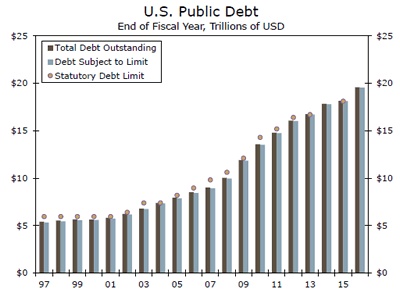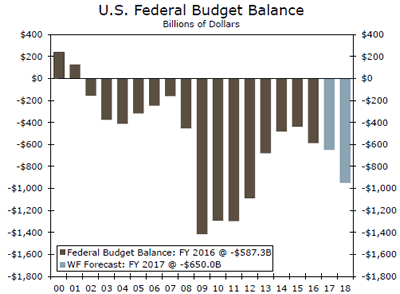U.S. Review
Two More Rate Hikes in the Cards This Year
- The Federal Reserve raised its short-term target rate 25 bps at its March FOMC meeting, with one dissent. Median projections were largely unchanged and still point to three hikes in 2017 and 2018. We expect some political uncertainty to seep in ahead of the June meeting.
- Headline and core nominal retail sales grew only marginally in February, suggesting a below-trend pace in personal consumption in Q1. Much of the slower pace can be attributed to a delay in tax refund payments. The severe snowstorm that hit the Northeast and parts of the Midwest is expected to pull some seasonally-sensitive monthly indicators lower in March.
Moving Beyond the Noise
The Federal Reserve raised its short-term target rate 25 bps at its March FOMC meeting, with one dissent. Median projections were largely unchanged and still point to three hikes in 2017 and 2018. The target range now rests between 0.75 percent and 1.0 percent. The timing of the next rate hike remains elusive, but with political risks looming including raising the U.S. debt ceiling and use of extraordinary measures (see the Topic of the Week on page 7), reignited Brexit talks, and the first-round for the French presidential election (April 23), some uncertainty is expected to seep in ahead of the June FOMC meeting.
The trend in oil prices will also be important to watch in the coming months, especially as prices have slipped and stockpiles have risen since the early December meeting when OPEC members and non-OPEC nations agreed to cut production. The next OPEC meeting will occur on May 25, and members will undoubtedly reevaluate production levels. As seen in retail sales and consumer prices in February, the slide in oil prices diluted headline activity. That said, with the pass-through from weak oil prices to core inflation largely behind us and goods prices increasing, we expect headline and core prices to continue to firm in the coming months.
Headline and core nominal retail sales grew only marginally in February, suggesting a below-trend pace in personal consumption in Q1. In part, the modest headline sales reading in February reflects a delay in tax refund payments for households that claim earned-income tax credits (EITC) or additional child tax credits (ACTC). According to the Internal Revenue Service (IRS), beginning this year, tax refunds for households that claim EITC or ACTC on their tax return were held until Feb. 15 but did not arrive until the week of Feb. 27. The delay is due to the Protecting Americans From Tax Hikes Act of 2015, which came into effect late last year and seeks to help the IRS verify claims. Such a delay could have some effect on the seasonal adjustment process and absent any adverse weather effect due to the March snowstorm we should see a rebound in activity in March.
Speaking of harsh winter conditions, unseasonably cold temperatures and the Nor’easter will likely show up in seasonallysensitive monthly indicators in March including average weekly hours, initial jobless claims, construction spending, retail sales, utilities output, housing starts and sales activity. In particular, the March storm marked the fifth episode over the past decade that fell on a work day during the nonfarm payroll (NFP) reference week. Indeed, headline NFP only slipped during one significant snowstorm, but the monthly difference in average weekly hours tumbled during each bout and the number of persons who usually work full time but had reduced hours due to bad weather also surged. Although headline NFP will likely be less affected by weather, other indicators could see an outsized downward swing in March as the snowstorm followed unusually mild temperatures in February. Putting it all together, Q1 economic activity is on track to register a weak reading, but activity should rebound in Q2.
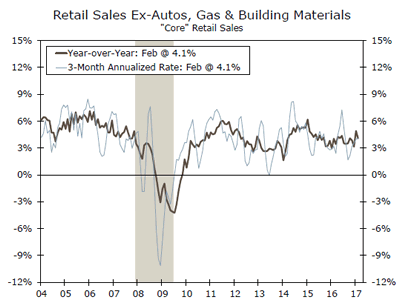
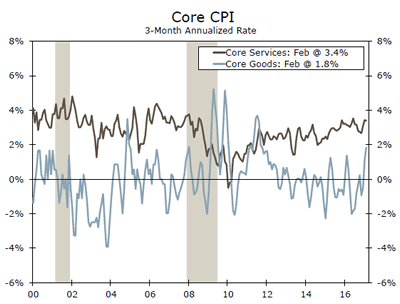
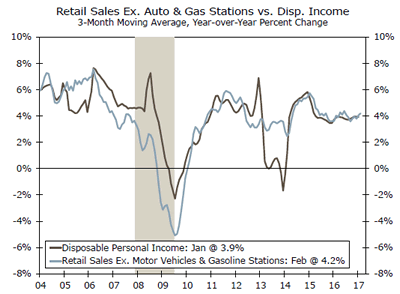
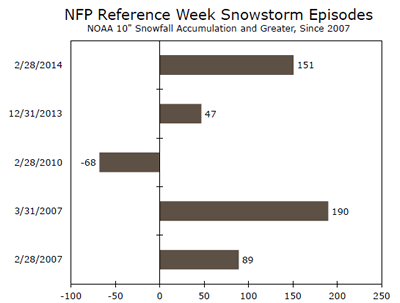
U.S. Outlook
Existing Home Sales • Wednesday
Existing home sales started 2017 on a strong note, with sales climbing 3.3 percent in January to a 5.69 million-unit pace. Home sales are now running at their strongest pace since the recession.
Inventory of single-family homes remained relatively unchanged at a 3.6 month supply. The persistence of historically low for-sale inventory is a big reason why prices continue to consistently beat expectations to the upside. The median price of an existing home rose a sizable 7.1 percent year over year in January.
The solid start to the year bodes well for Q1 estimates of realtors’ commissions, which show up in the residential investment component of GDP growth. That said, the late-winter storm that has affected much of the Northeast in mid-March may have had a negative effect on sales activity at the start of the spring home buying season.
Previous: 5.69 Million Wells Fargo: 5.52 Million Consensus: 5.58 Million
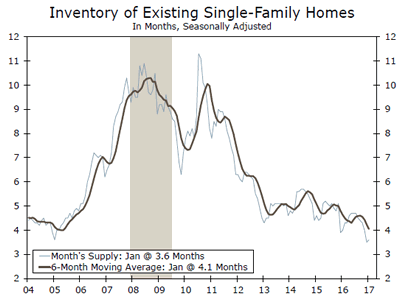
New Home Sales • Thursday
The pace of new home sales rose 3.7 percent to seasonally adjusted annualized rate of 555,000 units in January, partially recovering December’s loss. Sales for November and October were revised down, however. The lower sales figures suggest the post-election bump in mortgage rates may have taken a larger bite out of new home sales than previously reported.
With January’s gain, new home sales are up 5.5 percent on a yearover- year basis. Sales rose in every region except the West during the month. The unusually-wet weather in the West may have held back sales in January, but sales are still trending up on a threemonth moving basis. We expect new home sales to remain solid heading into the spring buying season, as market fundamentals, including homebuilder confidence and steady job growth, remain consistent with continued improvement in home sales. We look for sales to increase 2.5 percent to a rate of 569,000 units in February.
Previous: 555,000 Wells Fargo: 569,000 Consensus: 565,000
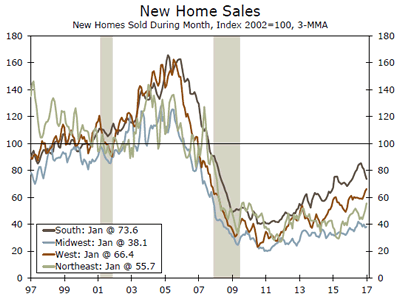
Durable Goods • Friday
Durable goods orders rose a larger-than-expected 1.8 percent in January. Despite the improvement in the headline, the details were less encouraging. Most of the pickup was due to an increase in the notoriously-volatile aircraft orders component, as government outlays on defense aircraft climbed 59.9 percent and civilian aircraft orders surged 69.9 percent. Stripping away the noise of transportation-related industry sectors, orders actually fell slightly in January. Moreover, core capital goods shipments—a proxy for current business spending—and orders of core capital goods—a leading indicator for future business spending—both declined in January. In each case, however, January’s drop followed upwardlyrevised figures for December.
Given the firming we have seen in survey data, from the NFIB survey of small businesses to the ISM survey of manufacturers, we think January’s stall in orders is likely temporary. continue to firm in 2017.
Previous: 1.8% Wells Fargo: 1.2% Consensus: 1.0% (Month-over-Month)
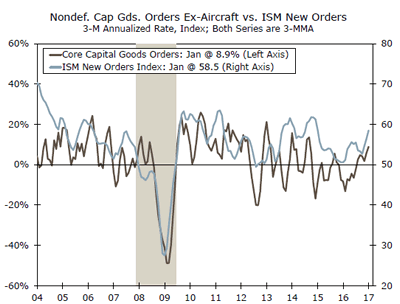
Global Review
Bank of England Keeps Rates Unchanged
- As largely expected, the Bank of England (BoE) voted in favor of keeping monetary policy unchanged at 0.25 percent at its meeting this week. Minutes from the meeting showed that the vote was non-unanimous with one dissenter voting to increase rates to 0.50 percent.
Strong Start to the Chinese New Year
- Data this week showed that China’s economy started the year off on solid footing. China’s fixed-asset investment and industrial production bested market expectations, while retail sales grew slower than expected due to weakness in auto sales.
Bank of England Keep Rates Unchanged
The U.K. economy has performed better than many had expected since the Brexit vote. In fact, the BoE nudged up its Q1 GDP forecast to 0.6 percent from 0.5 percent on non-annualized basis, last month. At its recent meeting, the central bank voted in favor of keeping monetary policy unchanged. Minutes from the meeting showed that the vote was non-unanimous, as one Monetary Policy Committee member voted to raise rates to 0.50 percent. The minutes also noted that the bank is willing to allow inflation to run above the 2 percent target temporarily to protect jobs and growth.
The jobless rate in the U.K. has declined to 4.7 percent—the lowest rate since 1975—and nearing "full" employment. At the same time, average weekly earnings are growing slower than expected; indicating that wage growth is not picking up with underlying inflation and could weigh on the consumer driven economy. That said, the tightness in the labor market should put pressure on wages.
The pickup in inflation makes a convincing case for a rate hike later this year. However, we do not expect for the BoE to do this as there have been no wage acceleration to support inflation and recent data point to weak spots in the economy. This, in addition to uncertainty surrounding Brexit negotiations and the triggering of Article 50 next month, leads us to believe that the BoE will keep rates unchanged for the remainder of the year.
Strong Start to the Chinese New Year
China released its latest fixed-asset investment, retail sales and industrial production (IP) data this week. Fixed-asset investment, which includes capital spent on infrastructure, real estate, machinery spending across the economy, grew 8.9 percent in January and February, besting expectations for an 8.3 percent gain. Investments by state-owned businesses also increased. The Chinese government has relaxed credit lending standards in the hopes of spurring real estate demand, which has paid off as residential investment has picked up over the past two quarters.
Growing demand for steel to meet the increase in infrastructure spending and a rebound in real estate investment has been a major boon to IP, up 6.3 percent year over year during January and February. The first two months of the year are typically combined to account for the time of the Lunar New Year holiday.
Retail sales figures, on the other hand, were lukewarm, expanding at a less-than-expected 9.5 percent clip during the January- February period and undershoot market expectations of a 10.6 percent increase. Disappointing automobile sales, as result of the government reducing tax breaks for small cars, weighed on growth, while consumers favored online shopping, which jumped 31.9 percent.
As the Chinese government moves away from debt driven growth and avoids a hard landing, the strength of the economy will depend largely on investment growth, as fiscal policy becomes less supportive. This will prove to be difficult to sustain over the long term as weak consumption will weigh on growth. On balance, this week’s data suggest that the economy started the year strong, but we expect growth to slow to 6.3 percent for 2017.
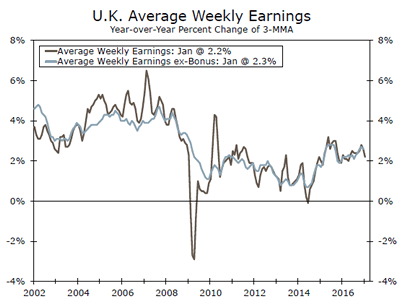
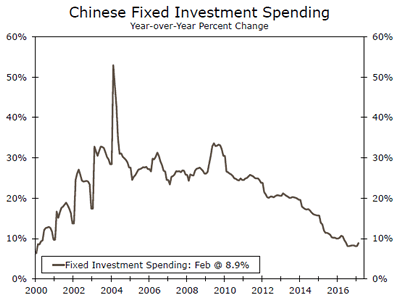
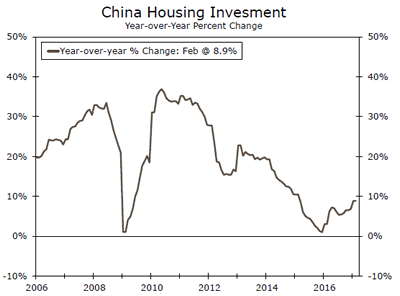
Global Outlook
Canadian Retail Sales • Tuesday
The Canadian economy slipped into a mild recession in early 2015 following the collapse in energy prices. Resilience in consumer spending during that period prevented, at least in part, the downturn from becoming deeper, and growth in Canadian consumer spending has generally remained solid subsequently. That said, retail sales slipped 0.5 percent in December relative to the previous month. Data that are slated for release on Tuesday will show how retail spending started the year.
CPI data for February are on the docket on Friday. The overall rate of CPI inflation is currently 2.1 percent, essentially in the middle of the Bank of Canada’s target range of 1 percent to 3 percent. However, different measures of the core rate of inflation remain below the mid-point. Consequently, we look for the bank to keep its main policy rate unchanged at 0.50 percent, where it has been maintained since July 2015, for the foreseeable future.
Previous: -0.5% (Month-over-Month)
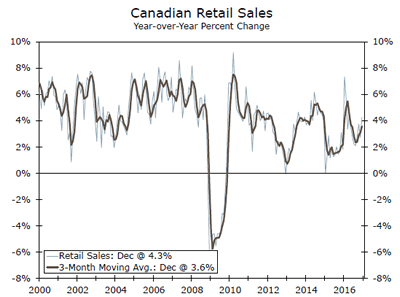
U.K. Retail Sales • Thursday
Consumers in the United Kingdom were the star economic performers in the British economy through most of last year. However, the volume of retail sales has contracted in four of the past five months, and real sales were up only 1.5 percent in January, the weakest year-over-year growth rate in three years. Did spending rebound in February? Data on the docket on Thursday will help gauge the current state of consumer spending.
Higher inflation may be weighing on growth in consumer spending recently. Consumer prices started 2016 more or less flat on a yearago basis. However, the most recent reading on CPI inflation had consumer prices up nearly 2 percent. Higher inflation helps depress growth in real spending via erosion in purchasing power. CPI inflation for February will print on Tuesday. Further acceleration in consumer prices could eventually induce the Bank of England to raise rates.
Previous: -0.3% (Month-over-Month) Consensus: 0.4%
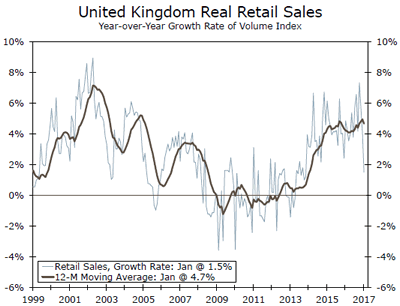
Eurozone PMIs • Friday
The purchasing managers’ indices in the Eurozone have risen sharply in recent months. In February, both PMIs stood above 55, the highest readings for both indices since early 2011. Unfortunately, incoming "hard" data do not exhibit the same level of economic resilience. For example, industrial production (IP) in the euro area was growing in excess of 4 percent (year 0ver year) in early 2011, the last time the manufacturing PMI exceeded 55. The underlying growth rate of IP today is about 2 percent. The March PMIs, which will print on Friday, will be interesting, but they may not tell analysts much about the "true" state of economic activity in the Eurozone today.
The ECB will conduct a quarterly tender for its Targeted Long-Term Refinancing Operations (TLTRO) on Thursday. Strong interest by banks in the Eurozone would indicate that growth in bank lending could strengthen further in coming months.
Manufacturing PMI:55.4 Consensus: 55.3 Services PMI:55.5 Consensus: 55.3
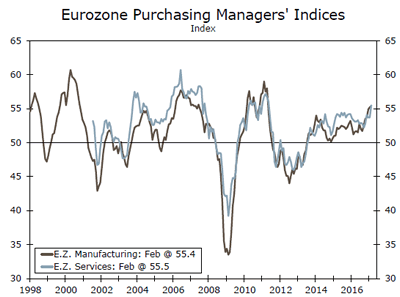
Point of View
Interest Rate Watch
Cyclical and Secular Credit Trends
Patterns in credit reveal clues about the cyclical and long-term character of credit trends and the ability of those markets to sustain economic growth.
Net lending at commercial banks (top graph) provides an excellent illustration of cyclical and secular trends. Net lending exhibits a clear pattern of peaking before the onset of a recession. This may appear surprising since bank lending is considered a lagging indicator of the economic cycle. In contrast, the actual behavior is that bank lending actually leads the cycle at the top and is coincident with the cycle on the upturn.
Meanwhile, the longer-term trend since the early 1990s was clearly on the upswing until the 2008-2009 recession. Yet, again in contrast to conventional wisdom, net lending has returned to a new high in recent quarters.
Who’s Borrowing?
Since the Great Recession, the biggest boom in credit market debt has been the government sector, not the household or the nonfinancial corporate sector (middle graph). Nonfinancial corporate debt has risen in the current expansion but remains much closer to historical levels than its government counterpart.
Meanwhile, the household sector exhibits a cyclical pattern that typically peaks as a recession begins but there is a modest longer-term upward trend that does not exhibit the amplitude of the nonfinancial and government sectors.
Government debt is the true outlier for two reasons. First, the current share of GDP is at all-time highs for government debt. Second, the break out since the Great Recession has been out of character since the 1960s.
Corporate CFOs as Rational Actors
Consistent with expectations, the steady decline in AA corporate bond yields has been accompanied by a steady decline in short-term debt as a share of total debt (bottom graph). Long-term financing has steadily increased since the mid-1980s as would be consistent with the same interest rate downtrend.
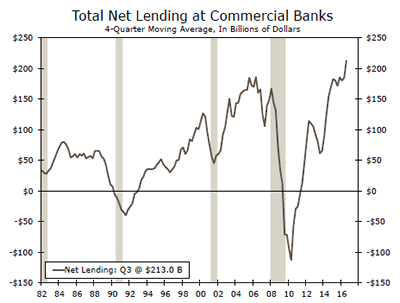
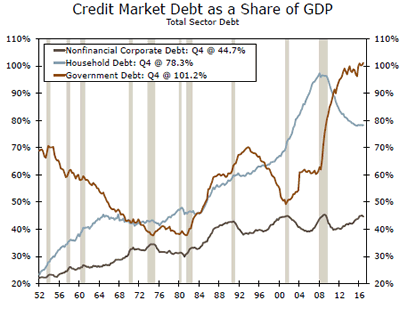
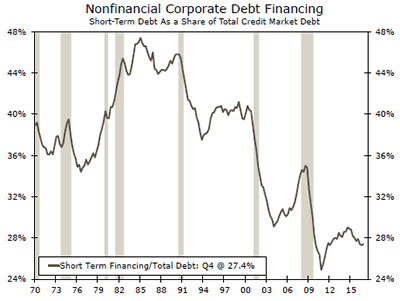
Credit Market Insights
Household Wealth Hits New Record
The Federal Reserve’s Financial Accounts of the United States for Q4 2016 show that household wealth in the United States increased $2.04 trillion to a hit a fresh record high of $92.8 trillion at the end of 2016. The strong stock market performance after the election certainly played a role, as did house price growth. Households’ financial assets, which reflect investment wealth, rose 2.1 percent in Q4, while nonfinancial assets, which include real estate values, rose 1.9 percent.
Households accumulated debt at a slightly slower pace in Q4, rising at a 3.8 percent annual rate, down from 3.9 percent in Q3. Consumer credit debt growth was behind the slowdown, as home mortgage debt rose at a slightly faster pace.
Consumer credit followed a similar path in the first month of 2017, according to the Federal Reserve’s monthly consumer credit report. January marked the smallest one month increase in consumer debt since 2012, reflecting households paying down credit card balances, as auto and student loans rose on the month.
Taken together, households’ balance sheets are in good shape on the aggregate. The average consumer is less burdened by credit card debt, while rising stock market and home values add to wealth. This bodes well for future personal consumption as households are increasingly comfortable with their financial situation, triggering the wealth effect and encouraging spending.
Topic of the Week
Debt Ceiling Hike a Ways Off
The nation’s borrowing limit has been suspended since November 2015 and on March 15, will reset to the total amount borrowed at that point in time, or roughly $20 trillion. Thursday of this week the Treasury began taking extraordinary measures to stay under the borrowing limit. These extraordinary measures, combined with the influx of revenues from tax collections in April, will keep the Treasury under the debt limit and with enough cash on hand to continue funding the government’s existing obligations.
The Congressional Budget Office (CBO) estimates a federal budget deficit for the current federal fiscal year of $559 billion. The CBO’s estimate of the budget deficit, however, relies on current law remaining unchanged. The current federal funding bill runs out on April 28, by which time Congress will need to enact another continuing resolution to keep the government operating. In our assessment, this new funding bill will be the product of bipartisan negotiations and thus will likely result in a higher budget deficit for the current fiscal year, $650 billion, in our view. Should our base case unfold, it is likely that Congress will need to lift the borrowing limit later this summer or at least before the end of the fiscal year in September. The exact timing will depend on the spending level agreed to next month as well as revenue collections in the coming months. We expect Congress will agree to a clean debt ceiling increase in April 2017 when it passes the next funding bill in order to avoid a contentious debate after the August recess.
During the last instance of the re-establishment of the debt ceiling from March to November 2015, there was little effect on net Treasury issuance while the Department of the Treasury enacted extraordinary measures to stay under the borrowing limit. We expect similar dynamics to play out this time. For further reading see our special report Capitol Hill Update: Debt Ceiling Hike a Ways Off available on our website.
